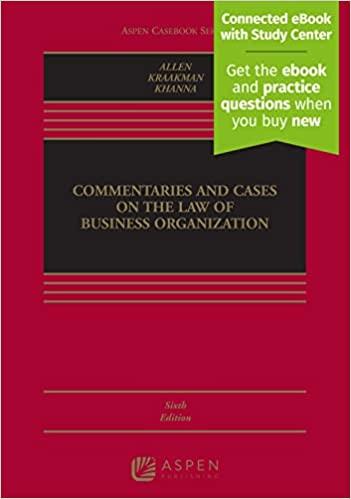Question
1. Mrs Bates is an elderly widow living alone who is dependent on her son Norman for advice and support. She has no business experience.
1. Mrs Bates is an elderly widow living alone who is dependent on her son Norman for advice and support. She has no business experience. Mrs. Bates has no income other than her pension but she does own her own home, which is valued at over $400,000. Norman convinces Mrs. Bates to borrow money to enable him to buy a new hotel business, assuring her that the repayments will be his responsibility; she just needs to sign the papers to 'back him up as guarantor' as the house is in her name.
Mrs. Bates applies to a finance company for a loan of $250,000 to lend to Norman to buy the business. The finance company lends her the money, taking as security a mortgage over her home. The loan documents are signed at the finance company's offices late at night without any explanation from the manager about their legal consequences or the consequences of non-payment of the loan sum. The manager of the finance company refuses to allow her to take the papers away, nor does he suggest that she receive any independent legal advice.
Six months later, Norman's business fails and it is revealed that he made only one loan repayment. The finance company is now threatening to sell Mrs. Bates home.
Advise Mrs Bates of
A. any actionshe may take against the finance company under common law contractual principles only.
B. fill out the below table
| Principle (state the area/s of law that apply to the scenario) | |
| Law (state the rules of law surrounding the principle/s you have identified above) | |
| Application to Facts (list the important facts of the above scenario) | |
| Case State the name of a previous case that has relevance to this scenario | |
| Conclusion (state the similiarities between the previous case and that of the scenario and advise Mrs Bates of the likely outcome based on the information you have identified above, and as required in the assessment instructions) |
2. Research the legislations in the following list and allocate them to the appropriate business structures below (hint: they do not all apply to each business structure and some apply to more than one structure):
Corporations Act 2001 (Cth)
A New Tax System (Goods and Services Tax) Act 1999
Trustees Act 1973
Competition and Consumer Act 2010
Partnerships Act (QLD) 1891
Income Tax Act 1997
Superannuation Guarantee (Administration) Act 1992
| Legislation | |
| Public Companies | |
| Private Companies | |
| Trusts | |
| Partnerships | |
| Sole Traders |
3. 1. Name the broad area of civil law that covers a wide range of wrongs.
2. How was the law of tort developed?
3. Identify the significant historical case applicable to duty of care.
4. Explain why the case in c) above is important.
Step by Step Solution
There are 3 Steps involved in it
Step: 1

Get Instant Access to Expert-Tailored Solutions
See step-by-step solutions with expert insights and AI powered tools for academic success
Step: 2

Step: 3

Ace Your Homework with AI
Get the answers you need in no time with our AI-driven, step-by-step assistance
Get Started


